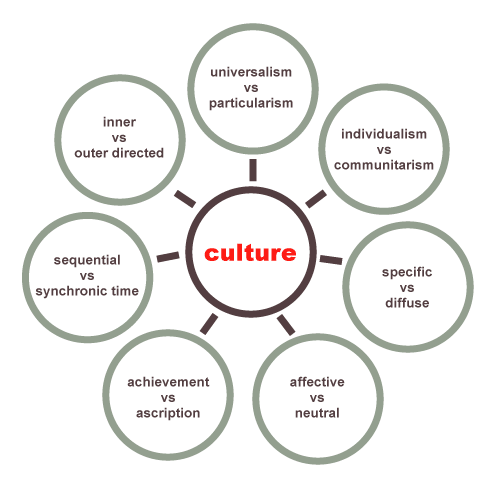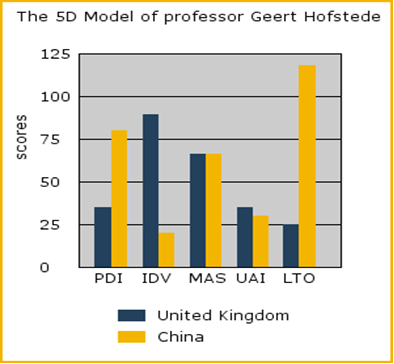Culture

According to Azhar (2003) organizational culture is the combination of important assumptions that are shared in common by each members of an organization and are often unstated. Organizational culture is basically made up by two major common assumptions: values and beliefs. Values are the assumptions that have been forwarded by the leaders of the organization and considered to be ideals that are desired by all the members of an organization. Beliefs on the other hand are the assumptions about the reality and created by experience. Robbins (1986) on the other hand, defines organizational culture as a uniform perception of an organization which has common characteristics. Organizational culture, according to the author is something descriptive and effectively it can distinguish one particular organization from another. It can also integrate individuals and groups of organization systems. Organizational culture is also defined by Rousseau (2000) as a set of commonly experienced stable characteristics of an organization which shows the distinctive features of an organization which differentiates it from others. Similar to the definitions of Azhar (2003) that has been stated above, Rousseau (2000) also define the organizational culture as set of norms and values that are shared by individuals and groups across the organization. Organizational values and beliefs refer to the common ideas about what the shared goals of an organization are, what types of behaviour should the members of an organization follow in order to achieve the common goals of an organization. These organizational values in turn form out the standard norms and guidelines for the organization that makes it distinct from others. Organizational culture is also defined by Schein (2004) as a pattern of shared assumptions that have been accepted by a group of individuals as they solve their problems. Because they have used these assumptions to solve their problems and…

Harrison (1972) presents a model of culture, known as Harrison’s Model of Culture that divides organisational cultures into the four categories: role, task, power, and person cultures. Organisations with role culture tend to be reliant on formal rules and regulations. In role culture organisations formal job descriptions of positions are more important than personal traits and characteristics of individuals taking these positions. In task culture organisations, on the other hand, the levels of skills and competencies to deal with tasks in hand are perceived to be the most important factor to exert influence. Task culture organisations tend to operate in project-based manner with specified deadlines for each project. Disadvantages of task culture organisations include conflicts of interests within teams and other relationship problems due to not clearly specified roles and responsibilities for team members. Power culture organisations tend to be highly autocratic, with a top executive exercising great power towards all organisational processes. The advantages of power culture in organisations can be listed as high speed of decision making and implementation of organisational changes. However, power culture is associated with a range of disadvantages as well that may include lack of constructive arguments and discussions, and lower level of employee motivation. In person culture organisations a specific individual serves as a source of influence for group members. This type of organisational culture is the least popular due to the fact that it lacks formal hierarchy, along with other disadvantages.

The theoretical framework of Cultural Dimensions introduced by Geert Hofstede as a result of assessing the values of more than 100,000 IBM workforce from 50 countries represent one of the most significant contributions to the development of cross-cultural studies. Hofstede differentiates cultures on the basis of following dimensions: individualism versus, collectivism, power distance, uncertainty avoidance, masculinity versus femininity, and long-term versus short-term orientation. Individualism versus Collectivism Individualism “describes the tendency of people to see themselves as individuals rather than as members of a group” (Velo, 2012, p. 26), whereas collectivism is associated with preference for group thinking and prioritising advantages of the group over individualistic advantages. In organisations where collectivistic culture prevails employees consider decision making to be the responsibility of superiors. Similarly, Andrews (2009) argues that employees in highly individualistic work cultures feel motivated to engage in decision making in an individual manner. Power Distance Power distance is an extent to which group members are willing to accept unequal distribution of power. In societies with high power distance unequal distribution of power is tolerated by group members to a great extent. Such societies managers are not generally approachable and the most popular form of communication is downward communication. In societies with low power distance, on the other hand, members of society are perceived to be more or less equal. Managers in low power distance organisations are viewed as peers by subordinates and there is usually two-way communication in such type of organisations. Uncertainty Avoidance Uncertainty avoidance dimension of culture refers to the degree of tolerance towards ambiguity and unexpected events and unstructured situations. Societies with high levels of uncertainty avoidance prefer to operate within highly structured environment and generally they have negative approach towards uncertainties. Bhattacharyya (2010) recommends the development of clear procedures and directives when…

Literature review has identified a set of factors that are able to trigger cultural changes. These factors causing cultural change have been found as leadership change, technological developments, mergers and acquisitions and others. Discussions of each of these factors in greater details are provided below. 1. Leadership Change Authors such as Beer (2012), Christopher (2012) and Morgan (2012) agree that changes in top level management can result in changes in organisational culture. According to Beer (2012), initially, organisational culture is set by the founder of the organisation, but the initial culture set by founders might be subjected to changes due to the impact of a wide range of factors. At the same time, Beer (2012) acknowledges that this argument relates to private sector organisations at a greater extent compared to public sector organisations. Nevertheless, Beer (2012) and Christopher (2012) argue that change at organisational leadership causes changes to organisational culture to a certain extent. Christopher (2012) further reasons that the extent to which organisational culture is subjected to change to due to change in leadership depends on a set of factors such as the difference between the new and old strategy to achieve organisational objectives, personal traits and characteristics of a new leader etc. 2. Technological Developments The extent of technological developments that have especially accelerated during the last two decades have been found as a major factor causing cultural changes by Maude (2011) and Davel et al. (2013). Maude (2011) mentions the instances of using mobile phones in public to illustrate the impact of this factor. Specifically, according to Maude (2011) while it was perceived to be a rather rude behaviour to engage in lengthy conversations in mobile phones in public places such as public transport only twenty years ago, nowadays such behaviour is generally perceived…
By John Dudovskiy
Category: Change

Trompenaars and Hampden-Turner Cultural Dimensions consists of universalism versus particularism, individualism versus collectivism, achievement versus ascription, neutral versus affective, specific versus diffuse, internal versus external, and time orientation. Universalism versus particularism relates to the extent of importance of formal rules and procedures over circumstances and relationships. Universalistic cultures rely on formal rules and regulations to govern various aspects of life, whereas members of particularistic cultures tend act according to circumstances. Bhattacharyya (2010) links this specific cultural dimension to the levels of paperwork and bureaucracy in organisations. According to Bhattacharyya (2010), the levels of organisational bureaucracy are usually greater in organisations with universalistic cultures compared to particularistic organisations. Individualism versus collectivism is similar to relevant cultural dimension proposed by Hofstede as discussed above. In individualistic cultures interests of individuals usually prevail over the interest of the group, whereas in collectivistic organisations the whole teams, rather than individuals are credited with organisational successes, as well as, failures. Achievement versus ascription marks the level of tolerance of society towards the pattern of distribution of power and status amongst members of society. This cultural dimension is quite similar to power distance cultural dimension presented by Geert Hofstede. In societies and organisations with achievement-oriented cultures power, status and other befits are provided for individuals that are high achievers. In ascription-oriented organisations, on the other hand, power and management positions are given on the basis of family backgrounds, age, gender and others. Moran et al. (2011), Maude (2011) and a range of other authors present convincing arguments about the advantages of achievement-oriented organisational cultures over ascription-oriented organisations in terms of increasing the level of effectiveness in achieving organisational objectives. Specifically, employees in achievement-oriented organisations are found to be better motivated to contribute to the achievement of organisational objectives compared to employees in ascription-oriented organisations. Neutral versus affective…

According to Hofstede’s model for cultural differences and analysis between China and UK, the following table has been produced in reference to the link provided. Adopted from: http://www.geert-hofstede.com/hofstede_dimensions.php?culture1=94&culture2=18#compare According to power distance index, the Chinese understanding of power distribution and inequality is more than two times higher than the UK expectations. This indicates that the Chinese team management style is inclined to one person in the organization to have higher power than others and that person is perceived to be in a higher position than others. And according to individualism aspect of the above table, theUKorganization culture tends to have more individualistic approach than that ofChina. This indicates that individualism is more developed inUKcompanies and team management than Chinese. The reaction to risk in both countries tends to be in a very similar level. However, in terms of planning, the UK culture indicates to have short term planning, whereas, the Chinese to be long term planning. Based on above analysis, it can be concluded that the following type of management would be most appropriate to operate the business unit effectively in China: The management style similar to autocratic, where management tends to have more power to run the company as collectivism is highly appreciated in Chinese organizations. This indicates that subordinates are happy to follow the leader. In terms of planning skills of management, a manager with long term planning goals should be most appropriate here as Chinese management and employees tend to think well into future. Gender does not make big difference as both countries tend to have same levels of approach to genders, according to table above. Therefore, a person who can work collectively with others, more challenging towards others and risk aware would be ideal for the manager position here. The person suitable for this position…

Widely considered as a controversial genius and a charismatic leader, Steve Jobs has served as chairman and CEO of Apple for 14 years and he is credited for the global success of the company. The decease of Steve Jobs on October 5, 2011 because of cancer implications resulted in grievances for millions of people around the globe, at the same time casting concerns for the future of Apple Inc. Although, a long-term Apple executive with impressive track record – Tim Cook has been named apple CEO several months before the decease of Steve Jobs, nevertheless, there are concerns about the sustainability of Apple’s innovative corporate culture, as this culture had been closely associated with the former CEO. Apple Organisational Culture on Steve Jobs Era Late Apple chairman and CEO, Steve Jobs is widely perceived as unconventional leader who was able to rally various stakeholders of the company for his vision and at the same time “demanded excellence from his staff and was known for his blunt delivery of criticism” (McInerney, 2011). According to Harrison’s Model of Culture (1972) Apple organisational culture when Steve Jobs was in charge can be classified as a power culture. Accordingly, Steve Jobs had concentrated most of the decision making powers at his hands, constantly challenging subordinates for better performance, and criticising employees blatantly and undiplomatically if their performances did not meet his expectations (Arneson, 2011). Moreover, described as “antithesis of servant leadership model” (Katzenbach, 2012), Steve Jobs was famous for pressurising teams and individuals to better performance and creating a corporate culture of high level of performance where A list employees would thrive, however B list employees, comprising the majority of workforce, would be subjected to unnecessary level of stress. According to Harrison’s Model of Culture (1972) the power culture has both advantages, as well…
